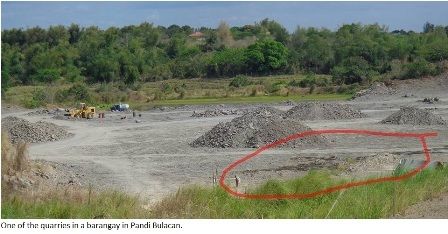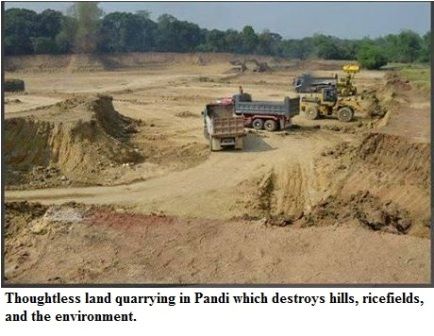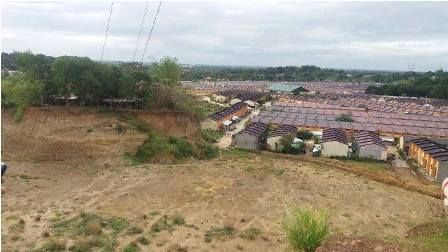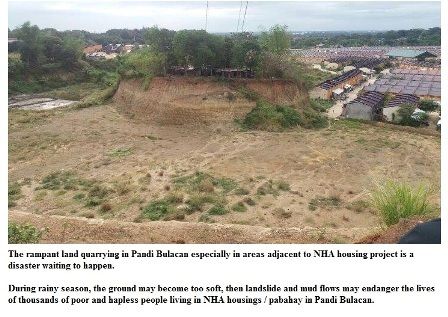*The author is Ph.D. in Resource Economics and Senior Research Fellow at the Philippine Institute for Development Studies (PIDS).
Quarrying has been going on for many years in the Philippines in support of the country’s infrastructure and overall economic development. The most important products of this activity are rock aggregates, colloquially known as sand and gravel (Martin and Discipulo 1996). For the 1985- 1998 period, the average annual national sand and gravel production was valued at approximately P4 billion. Said production formed a significant 39.33 percent of the nonmetallic mineral output and 14.49 percent of total mineral production (Table 1). In addition, the shares of sand and gravel output to nonmetallic mineral and total mineral production generally have been increasing, further manifesting the importance of quarrying to the mining industry.
While quarrying is important, it is also a major natural resource extractive sector that causes significant environmental problems. These problems are now only beginning to be understood. Unlike in mining where operations are generally large-scale and the degradation impacts are obvious, operations in quarrying are relatively small-scale and the effects are less evident. Moreover, in the minds of many people, quarrying is only a secondary component of the entire mining industry.
Recently, the environmental problems related to quarrying were brought to the forefront by widespread multi-sectoral protests against its destructive effects in the municipalities of Rodriguez and San Mateo in the province of Rizal. The protest actions eventually led to the suspension of quarrying operations in the area for several months in 1998 until early 1999 (Martin 2000). The activity was later allowed to resume, but only under very strict guidelines and preconditions set by the Department of Environment and Natural Resources (DENR). Environmental impacts of quarrying Basically, there are two types of quarrying operations, namely, mountain quarrying and river quarrying. Both have potentially significant negative environmental
Environmental impacts of quarrying.
Basically, there are two types of quarrying operations, namely, mountain quarrying and river quarrying. Both have potentially significant negative environmental impacts. In the case of mountain quarrying, the activity results in the scraping of the upland topsoil and vegetation and the destruction of the aesthetic value of the quarried area. River quarrying, on the other hand, leads to the uneven deepening of the riverbeds and the destruction of the riverbanks. Both types of quarrying further cause soil erosion, pollution, siltation and the flooding of downstream bodies and areas. In addition to these, quarrying operations produce dusts along their transportation routes and noise pollution in quarry sites, much to the detriment of the affected population. A recent study in Palawan for the Impact of Macroeconomic Adjustment Policies on the Environment (IMAPE) Project by Israel, Sandalo and Torres (2001) confirmed the negative environmental impacts, particularly of river quarrying. Using Rapid Rural Appraisal (RRA) methods, the authors found that both the quarrying firms and the households affected by the activity in the province recognized the occurrence of various environmental problems associated with the activity. Furthermore, a significant number of households believed that they suffered from the ill effects of quarrying and that quarrying operators are not doing enough to address the problems.
Please read more at the below link :
* * * *
QUARRYING IN PANDI BULACAN
Quarrying started in the town of Pandi in the 1970s during the time of Andres Dynasty, During that time only hills (gulod) were quarried and as I remembered the quarried land from Pandi was first used as top soil in the construction of Manila North Diversion Road now named North Luzon Expressway.
As per some posting in Facebook and from my interviews of some legitimate residents of Pandi, the quarrying in Pandi is now rampant and unregulated, the quarrys depth is almost the same height of bamboo trees, so the depth is from 20 to 50 meters.
Recently there were some reports in Facebook that the quarried land is so dangerous that some houses adjacent to quarys may collapse anytime. Also the NHA "pabahay" adjacent and or in the vicinity of quarrys were in danger.
Photos of quarrying business in Pandi.
* * * * *
Related postings in Facebook about Quarrys in Pandi
* * * * *
YouTube Videos
Quarrying in Pandi Bulacan
Pandi - Exodus
Pandi Aming Bayan





Walang komento:
Mag-post ng isang Komento